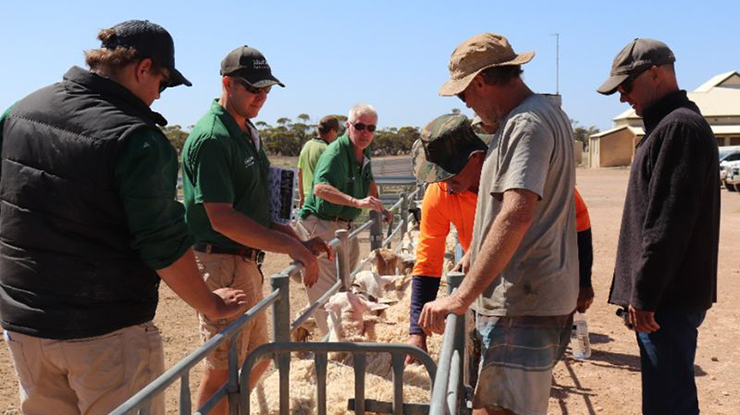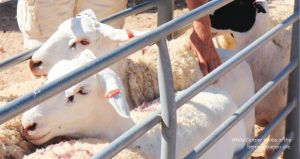
Image: South Australian White Dorper producers at a demonstration site project.
The adoption of some key management practices has helped a group of producers running self-replacing White Dorper flocks increase their weaning percentages in a Meat and Livestock Australia (MLA) funded Producer Demonstration Site (PDS) project.
Anne Collins, AC Ag Consulting, and Daniel Schuppan, Nutrien Ag Solutions, coordinated the three-year project, which brought together a group of producers from South Australia’s far west coast region, to address falling reproductive rates in their flocks.
Mrs Collins said the project aimed to demonstrate locally, the value of management strategies that are accepted elsewhere as best practice.
The producer group learnt about key management strategies that could influence the reproductive performance of their flock.
Training was undertaken in condition scoring of ewes, feed budgeting and pre-joining ram assessment.
The value of pregnancy scanning for multiples and differential management of single and multiple bearing ewes, lambing multiple bearing ewes in smaller mobs and optimum time of weaning were all discussion points for the group.
In addition, the value of managing ewe condition score and feeding appropriately, identifying dry ewes at marking, assessing ewe udder soundness and vaccination for Campylobacter were examined.
Mrs Collins said the project was able to demonstrate that the adoption of recommended best management practices could result in superior weaning percentages.
These included:
- monitoring the condition score of ewes;
- using preg scanning as a tool to enable differential management of twin and single bearing ewes, lambing multiple bearers in smaller mobs;
- culling for udder faults;
- effective pre-joining ram checking and management;
- adoption of appropriate animal health strategies;
- timely weaning, and
- effective feed budgeting.
The group of producers included Ben Polkinghorne, Penong, who was able to lift the marking rate in his annually joined, self-replacing White Dorper flock by as much as 30 per cent over the three years of the project.
Ben Polkinghorne’s flock was one of the key demonstration sites. A mob of 200 of his ewes was individually identified using eID tags and their performance monitored over the course of the project. The conception rate of the monitored group of ewes increased by 27pc, from 125pc to 159pc in this time.
Ben felt the key practice that ultimately helped lift the overall flock marking rate from 99pc to 137pc across the course of the project was monitoring ewe condition score and feeding appropriately.
“One of the key changes we have made is to bring forward our weaning date so that the ewes have more time to recover and get back into good condition for joining,” Ben said.
Ben was already pregnancy scanning for multiples prior to the project but was not consistently managing them differentially for lambing.
Tracking of individual ewes through the project was able to confirm the importance of doing this and illustrate the impact of the extra demand from twin lambs on ewe body condition score.
Above average rainfall during joining in summer 2021-22 helped to capitalise on the changes that had been implemented.
Another flock that was monitored as part of the project was trialling six-monthly joining.
Tracking of individual ewes in this flock provided a good insight into the impact of ewe condition score at joining on conception rate.
The best conception rate was achieved at condition score four and above, with ewes less than score three at joining having reduced conception rates.
At the conclusion of the project, all the producers who had participated indicated that they had already adopted the majority of the demonstrated best management practices, or that they intended to.
A full copy of the project report will be available on the MLA website in the near future.
The University of Adelaide, working in conjunction with AC Ag Consulting and other consultants will soon commence an MLA supported five year research project examining reproduction rates of all shedding sheep breeds across Australia.

2023 DSSA Journal, Page 14 – 15.
CLICK HERE TO DOWNLOAD YOUR FREE DIGITAL COPY OF THE 2023 DSSA MAGAZINE!

